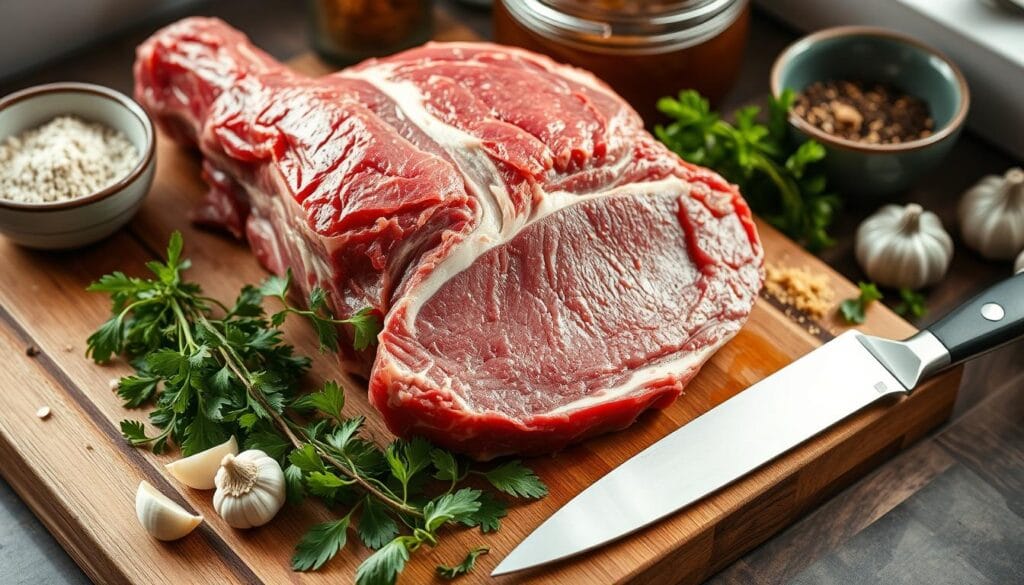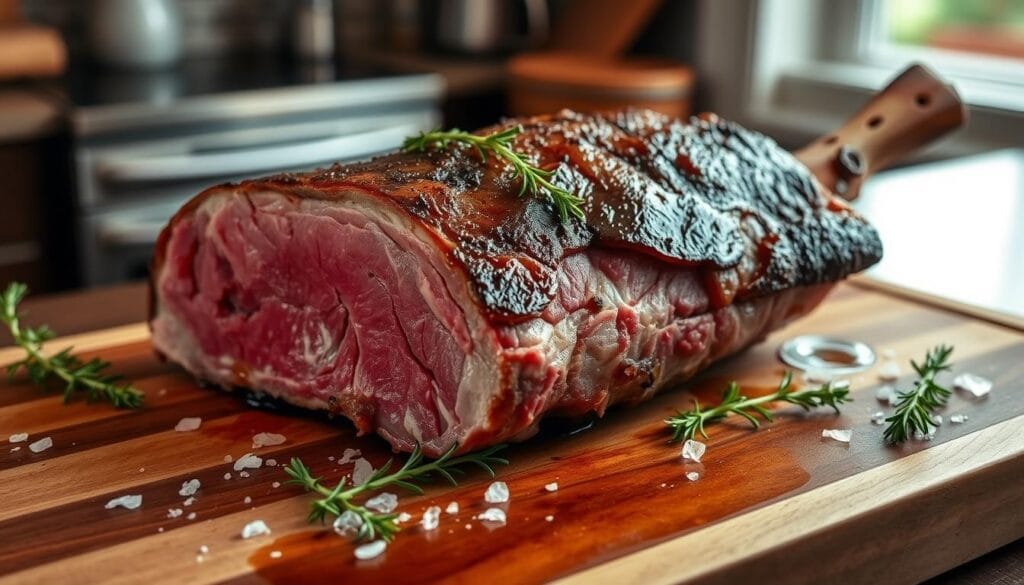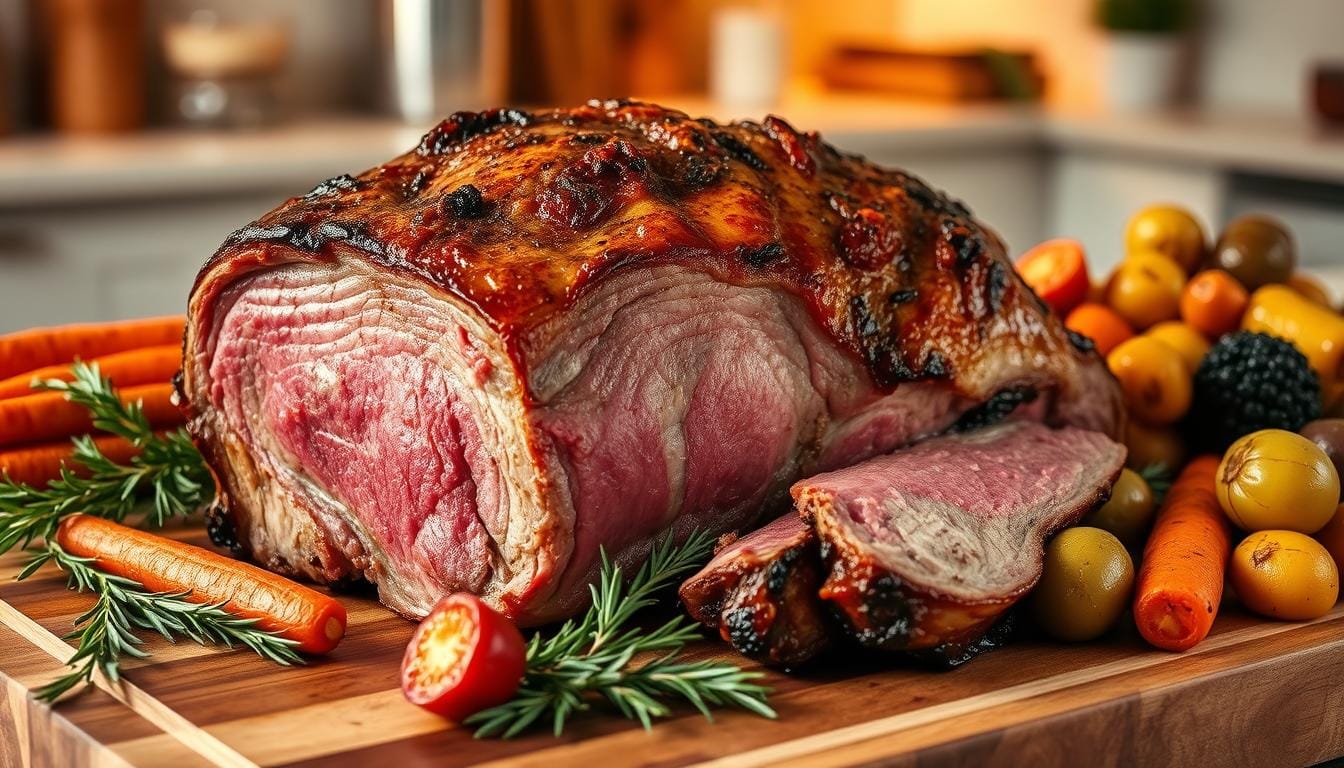Get ready to wow your guests with a delicious boneless rib roast recipe. It’s perfect for special occasions. This guide will show you how to make a mouthwatering dish that everyone will love. The boneless rib roast recipe is known for its tender and flavorful results.
Our recipe is easy to follow and needs just a few ingredients. It’s great for both seasoned chefs and beginners. The secret to a great boneless rib roast is in the cooking method. We’ll share the best techniques to make your roast juicy and full of flavor.
Introduction to Our Recipe
In this section, we give you a quick overview of our boneless rib roast recipe. We aim to provide a complete guide. It covers everything from key ingredients to cooking methods and presentation tips.
Key Takeaways
- Our boneless rib roast recipe is perfect for special occasions
- The recipe is easy to follow and requires minimal ingredients
- Cooking method is key to a great boneless rib roast
- Our guide covers everything from ingredients to presentation tips
- With our recipe, you’ll achieve a tender and flavorful boneless rib roast
- Our introduction to boneless rib roast provides a complete guide
- Our boneless rib roast recipe is designed for both beginners and seasoned chefs
Introduction to Boneless Rib Roast
A boneless rib roast is a cut of beef from the rib section, with bones removed. It’s known for its tenderness and flavor. Many ask, is a boneless rib roast the same as prime rib? They come from the same area but are not the same. A standing rib roast, with bones, adds flavor to the meat while cooking.
Choosing between a boneless rib roast and a standing rib roast depends on several factors. Here are some benefits of a boneless cut:
- Easier to carve and serve
- Less messy to cook and handle
- Can be cooked more evenly, resulting in a tender and juicy final product
Some say a standing rib roast tastes better because of the bones. But a boneless rib roast can also be very tasty if cooked right. It’s important to know the differences and choose what’s best for you. Whether it’s for a special occasion or a simple meal, a boneless rib roast is a great choice.
In the next section, we’ll explore the key ingredients for a delicious rib roast. We’ll look at the best beef to use and essential seasonings.
Key Ingredients for Rib Roast
To make a tasty boneless rib roast, you need the right ingredients. A good rib roast recipe includes quality beef, essential seasonings, and optional extras. Choose a beef cut that’s tender and has good marbling for better flavor and texture.
The main ingredients for a rib roast fall into a few groups:
- Beef selection: Pick a top-notch beef cut, like prime rib or ribeye, for the best taste and tenderness.
- Essential seasonings: Mix salt, pepper, and herbs like thyme and rosemary to boost the beef’s natural taste.
- Optional flavor additions: Add garlic and onions or use a marinade to give the roast extra flavor.
Knowing the key ingredients and how to pick the best ones will help you make a delicious rib roast.
Next, we’ll look at how to prepare the rib roast. This includes trimming the meat and seasoning it right. With the right ingredients and preparation, you’ll have a tasty boneless rib roast for any event.
| Ingredient | Description |
|---|---|
| Beef cut | High-quality beef cut, such as prime rib or ribeye |
| Essential seasonings | Salt, pepper, and herbs like thyme and rosemary |
| Optional flavor additions | Aromatics like garlic and onions, or marinades |
Preparing the Rib Roast
To make a tasty boneless rib roast, follow a few important steps. First, trim the meat to cook evenly and season it for flavor. Start by removing any extra fat from the roast. This helps the seasonings get into the meat better.
Then, think about how to season the roast. You can use dry rubs, marinades, or injections. Each method brings its own flavor. A How long to cook prime rib boneless per pound chart can help with cooking times, based on the roast’s size.

- Make a dry rub with salt, pepper, and herbs.
- Marinate it in olive oil, garlic, and rosemary for more flavor.
- Inject it with beef broth or red wine to keep it moist.
By following these steps and trying different seasonings, you’ll make a delicious boneless rib roast. Always check a How long to cook prime rib boneless per pound chart to cook it just right.
Cooking Methods for Boneless Rib Roast
There are many ways to cook a boneless rib roast, each with its own benefits. A common question is, Do you cook a boneless prime rib roast fat side up or down? The answer depends on the cooking method you pick.
Three main methods are oven roasting, sous vide, and slow cooker. Oven roasting gives a crispy crust. Sous vide ensures a tender interior. Slow cooker is easy and convenient.
Oven Roasting
Oven roasting is a classic choice. Preheat to 325°F (160°C). Put the roast in a roasting pan, fat side up. Roast for 15-20 minutes per pound, until it’s done to your liking.
Sous Vide Technique
Sous vide is great for a tender roast. Seal the roast in a sous vide bag. Cook at 130°F (54°C) for 2-3 hours, until it’s just right.
Slow Cooker Method
Slow cooker method is easy. Place the roast in the slow cooker, fat side up. Cook on low for 8-10 hours, until it’s perfectly cooked.
To cook a delicious boneless rib roast, choose the right method. Follow these tips for a tender and flavorful roast. It will impress everyone.
| Cooking Method | Temperature | Cooking Time |
|---|---|---|
| Oven Roasting | 325°F (160°C) | 15-20 minutes per pound |
| Sous Vide Technique | 130°F (54°C) | 2-3 hours |
| Slow Cooker Method | Low | 8-10 hours |
Ideal Cooking Temperatures
Cooking a standing rib roast to the right temperature is key for the perfect doneness. The right cooking temperatures are important for a great roast.
The best temperature for a boneless rib roast is between 130°F and 135°F for medium-rare. This range keeps the meat tender and juicy.
Understanding Doneness
Knowing the different doneness levels is important for a standing rib roast. The levels are:
- Medium-rare: 130°F – 135°F
- Medium: 140°F – 145°F
- Well-done: 160°F – 170°F
Using a Meat Thermometer
A meat thermometer is a must for the right roast temperature. It lets you check the roast’s internal temperature. This ensures it’s cooked just how you like it.
Resting the Roast
After cooking your rib roast to perfection, it’s key to let it rest. This step helps the juices spread out and the meat relax. This makes it tender and flavorful. Resting the roast is a simple yet vital process that greatly improves your dish.
Resting your roast lets the juices spread out, keeping it moist and tasty. This is very important for a rib roast, as it can dry out if not rested right. By resting, you can slice it better and enjoy it more.
Importance of Resting
Resting your roast is very important. Many skip this step, but it’s essential for the best results. Resting lets the meat relax and the juices spread out, improving tenderness and flavor. It also makes slicing and serving easier and keeps the meat moist.
How Long to Rest
The resting time depends on the roast’s size and type. Generally, rest it for 10-15 minutes before slicing. This allows the meat to relax and the juices to spread, making it tender and flavorful. For a rib roast, rest it for 20-30 minutes for the best results.

By following these steps and resting your roast, you’ll get a tender and flavorful dish. Always let it rest before slicing and serving. Use a meat thermometer to ensure it’s cooked safely.
| Roast Size | Resting Time |
|---|---|
| Small (2-3 pounds) | 10-15 minutes |
| Medium (4-6 pounds) | 15-20 minutes |
| Large (7-10 pounds) | 20-30 minutes |
Carving the Boneless Rib Roast
Carving a boneless rib roast needs skill and practice. But with the right techniques, you can make a stunning presentation. When you think Is a boneless rib roast the same as prime rib?, remember they’re similar but different. The main difference is the bone. A boneless roast is easier to carve and serve because it’s been deboned.
To start carving the boneless rib roast, you’ll need a sharp knife and a carving board. It’s important to slice against the grain for tender and flavorful meat. Here are some tips to keep in mind:
- Use a sharp knife to prevent tearing the meat
- Let the roast rest for a few minutes before carving to allow the juices to redistribute
- Slice the meat into thin strips or slices, depending on your desired presentation
A well-carved boneless rib roast can be a stunning centerpiece for any meal. Consider adding garnishes or sauces to enhance the presentation and flavor. With practice, you’ll become a pro at carving the boneless rib roast and impressing your guests with your culinary skills.
By following these tips and techniques, you’ll be able to create a beautifully carved boneless rib roast that’s sure to impress. Remember to always use a sharp knife and slice against the grain for the best results.
| Carving Technique | Description |
|---|---|
| Slicing against the grain | Cutting the meat in the direction perpendicular to the lines of muscle |
| Letting the roast rest | Allowing the meat to sit for a few minutes before carving to redistribute juices |
Serving Suggestions
There are many ways to serve a boneless rib roast. You can pair it with roasted veggies, mashed potatoes, or a fresh salad. To get it right, check out a How long to cook prime rib boneless per pound chart?. It helps you cook it perfectly and plan your meal.
A boneless rib roast goes well with many sides. Here are a few ideas:
- Roasted Brussels sprouts with balsamic glaze
- Sautéed mushrooms with garlic and thyme
- Creamy mashed potatoes with rosemary
These sides enhance the roast’s flavor and add variety to your meal.
Don’t forget about wine pairings to make your meal even better. Cabernet sauvignon and pinot noir are great choices. They match the roast’s rich taste and add elegance to your dinner. For Serving suggestions, slice the roast thinly and serve with horseradish sauce or au jus.
With these ideas, you’ll create a memorable and tasty meal. Whether it’s for a special event or a simple dinner, a boneless rib roast will impress everyone.
Storing Leftovers
Storing leftovers from your boneless rib roast is key to keeping the meat safe and tasty. Storing leftovers means following food safety rules, like refrigeration and freezing. It doesn’t matter if you cook a boneless prime rib roast fat side up or down.
Let’s look at how to store leftovers the right way. Here are some important tips:
- Refrigerate leftovers quickly, within two hours of cooking.
- Use airtight, shallow containers to keep moisture and contaminants out.
- Label and date the containers, so you can track how long they’ve been stored.
It’s also smart to think of new ways to use leftovers. You could make a tasty soup or sandwich with the leftover roast. This way, you can enjoy your boneless rib roast for longer, while also saving food.
For more ideas, here’s what a famous chef says:
The key to making the most of your leftovers is to think outside the box and come up with new, exciting ways to use them.
By following these tips and getting creative, you can enjoy your boneless rib roast for days. You’ll also reduce food waste and stay safe in the kitchen.
Conclusion
Exploring the boneless rib roast recipe shows it’s truly worth the effort. Choosing a top-quality beef cut and seasoning it right makes a big difference. Cooking it to perfection will impress your guests and satisfy your taste buds.
We’ve talked about the importance of picking the right cut and mastering cooking techniques. Also, making sure the roast is cooked to the perfect temperature is key. With these tips, you’ll be able to make a delicious boneless rib roast every time.
So, what are you waiting for? Start by gathering your ingredients and preheating the oven. This dish is perfect for any special occasion or a treat for yourself. Enjoy the delicious flavors of a perfectly cooked boneless rib roast. Bon appétit!

